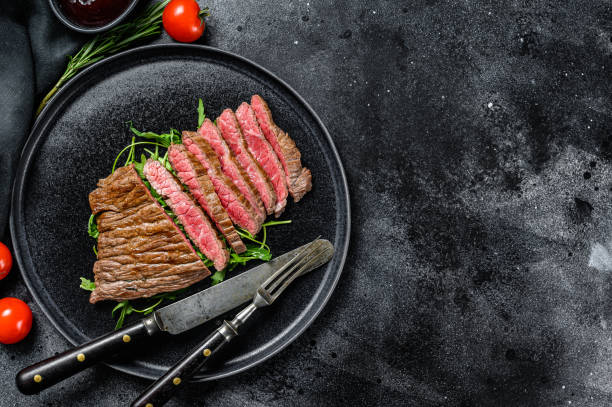When it comes to savoring a perfectly cooked steak, it’s not unusual to hear the request for “medium rare.” But have you ever wondered why this particular level of doneness is so popular? The choice of how to cook a steak is a matter of personal preference, and medium rare has become a favored option for numerous steak enthusiasts.
The Art of Cooking Steak
Cooking a steak to perfection is an art that combines the right cut of meat, precise techniques, and attention to detail. It’s about bringing out the steak’s natural flavors and textures while delivering a harmonious balance of taste and tenderness. Among the various degrees of doneness, such as rare, medium, and well-done, medium rare occupies a special place in the hearts of many steak aficionados.
What Does “Medium Rare” Mean?
To understand the appeal of medium rare, it’s essential to define this level of doneness. In the culinary world, “medium rare” refers to a steak that has been cooked to an internal temperature of around 130-135°F (54-57°C). At this point, the steak retains a warm, pink, and juicy center while having a slightly seared, browned exterior.
Culinary Science of Medium Rare Steaks
The popularity of medium rare steaks is not arbitrary; it’s rooted in the culinary science that makes this doneness level so appealing. Here are some key factors contributing to its desirability:
1. Flavor Development
At medium rare, the steak’s interior retains its natural juices and flavors. This level of doneness allows the Maillard reaction and caramelization to occur on the steak’s surface, creating a savory crust while keeping the interior tender and juicy.
2. Texture and Tenderness
Cooking a steak to medium rare ensures that the muscle fibers have had sufficient time to break down, resulting in a tender and palatable texture. Overcooking can lead to a tougher, drier steak.
3. Food Safety
Medium rare steaks are cooked to an internal temperature high enough to kill any harmful bacteria on the surface while still preserving the meat’s quality. This balance of safety and flavor is crucial.
The Sensory Experience
Medium rare steaks offer a unique sensory experience that captivates the palate. Here’s why this level of doneness is favored by many:
1. Juiciness
The juiciness of a medium rare steak is unparalleled. With the interior still pink and moist, each bite releases a burst of flavorful juices that enhance the overall taste.
2. Flavor Complexity
Medium rare steaks boast a balance of rich, meaty flavors and a delightful seared crust. This complexity is often lost in well-done steaks, which can taste one-dimensional.
3. Visual Appeal
Medium rare steaks are visually appealing, with a warm pink center and an inviting sear on the outside. The contrast in colors adds to the overall enjoyment of the meal.
Psychological Factors
The preference for medium rare steaks is not solely based on taste and texture; psychological factors also play a role. Here are some aspects to consider:
1. Tradition and Perception
Medium rare has become a traditional standard for steak doneness. Many people have grown up with this concept, and it often shapes their expectations and preferences.
2. Steakhouse Influence
Steakhouses, known for their expertise in cooking steaks to perfection, typically offer medium rare as the default or recommended doneness. This influence further solidifies its popularity.
3. Fear of Overcooking
Overcooking a steak can lead to a dry and less flavorful result. The fear of ruining a good steak may drive people to opt for medium rare to ensure they don’t miss out on the steak’s full potential.
Personalization and Choice
While medium rare is a popular choice, it’s essential to remember that steak doneness is a matter of personal preference. Some individuals prefer rare steaks, where the center is cool and red, while others opt for medium or well-done steaks. The beauty of steak is that it can be cooked to suit a wide range of tastes.
Adventures in Doneness
Exploring different levels of steak doneness can be a culinary adventure. Some might find that medium rare is their ideal choice, offering the perfect balance of flavor, texture, and juiciness. Others may discover a love for rare steaks, appreciating the primal and intense meatiness, while some may prefer the tenderness and reduced pinkness of a medium steak.
Serving Medium Rare Steaks Safely
Serving medium rare steaks safely is essential. While medium rare is cooked to a point that eliminates surface bacteria, it’s essential to handle and cook the steak with care. Here are some tips:
- Use a meat thermometer: Ensure the steak reaches an internal temperature of 130-135°F (54-57°C) to guarantee both safety and flavor.
- Rest the steak: Allowing the steak to rest for a few minutes after cooking redistributes the juices and ensures a juicy, evenly cooked steak.
- Quality meat: Start with high-quality, properly handled meat to reduce the risk of contamination.
- Clean cooking equipment: Maintain a clean kitchen and utensils to minimize the risk of cross-contamination.
- Personal preference: Respect individual preferences and always ask guests how they would like their steak cooked.
Medium rare steaks hold a special place in the culinary world, capturing the hearts of those who appreciate the perfect balance of flavor, tenderness, and juiciness. Whether it’s the science behind it, the sensory experience, or the influence of tradition and perception, medium rare is a beloved choice for steak lovers.
